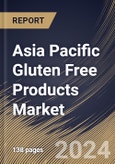Plant-based and ancient grains have gained prominence in gluten-free formulations. Quinoa, amaranth, sorghum, and teff are among the grains that are not only gluten-free but also bring unique nutritional profiles to gluten-free products, aligning with the broader trend toward plant-based diets. Moreover, nutritional fortification has become a key focus in developing gluten-free products.
Manufacturers are fortifying gluten-free alternatives with vitamins, minerals, and other nutrients to address potential nutritional gaps arising from excluding gluten-containing grains. Traditional gluten-containing grains are significant sources of plant-based proteins. In gluten-free products, the protein content can be comparatively lower. To address this, manufacturers are exploring protein-rich alternatives such as quinoa, chickpea flour, and pea protein, infusing gluten-free products with an added protein boost.
As awareness about celiac disease increases in China, more individuals may seek medical attention and get diagnosed with the condition. Improved diagnostic tools and healthcare infrastructure can contribute to more accurate and timely identification of celiac disease cases. As per the data from the National Library of Medicine, in the serological survey, 0.94% (13/1390) of individuals were positive for celiac disease (CD) antibodies. In a meta-analysis of 18 studies, the seroprevalence of CD in the general Chinese population was 0.27%, while that in the high-risk population was 8.34%. 4.44 percent was the prevalence of CD as confirmed by biopsy in high-risk Chinese populations. Thus, the growing prevalence of celiac disease and health and fitness trends in Asia Pacific will lead to the expansion of the regional market.
The China market dominated the Asia Pacific Gluten Free Products Market by Country in 2022, and would continue to be a dominant market till 2030; thereby, achieving a market value of $1,014.4 million by 2030. The Japan market is registering a CAGR of 9.7% during (2023 - 2030). Additionally, The India market would showcase a CAGR of 11.1% during (2023 - 2030).
Based on Distribution Channel, the market is segmented into Supermarkets & Hypermarkets, Specialty Stores, Convenience Stores, Online, and Others. Based on Product, the market is segmented into Bakery Products, Condiments, Seasonings, Spreads, Prepared Foods, Pasta & Rice, Dairy/Dairy Alternatives, Meats/Meats Alternatives, Desserts & Ice-creams, and Others. Based on countries, the market is segmented into China, Japan, India, South Korea, Singapore, Malaysia, and Rest of Asia Pacific.
List of Key Companies Profiled
- The Kraft Heinz Company
- Kellogg Company
- General Mills, Inc.
- PepsiCo, Inc.
- Chobani LLC
- Premier Foods PLC
- Danone S.A.
- The Hain Celestial Group, Inc.
- Conagra Brands, Inc.
- Dr. Schär AG / SPA
Market Report Segmentation
By Distribution Channel- Supermarkets & Hypermarkets
- Specialty Stores
- Convenience Stores
- Online
- Others
- Bakery Products
- Condiments, Seasonings, Spreads
- Prepared Foods
- Pasta & Rice
- Dairy/Dairy Alternatives
- Meats/Meats Alternatives
- Desserts & Ice-creams
- Others
- China
- Japan
- India
- South Korea
- Singapore
- Malaysia
- Rest of Asia Pacific
Table of Contents
Companies Mentioned
- The Kraft Heinz Company
- Kellogg Company
- General Mills, Inc.
- PepsiCo, Inc.
- Chobani LLC
- Premier Foods PLC
- Danone S.A.
- The Hain Celestial Group, Inc.
- Conagra Brands, Inc.
- Dr. Schär AG / SPA
Methodology

LOADING...








